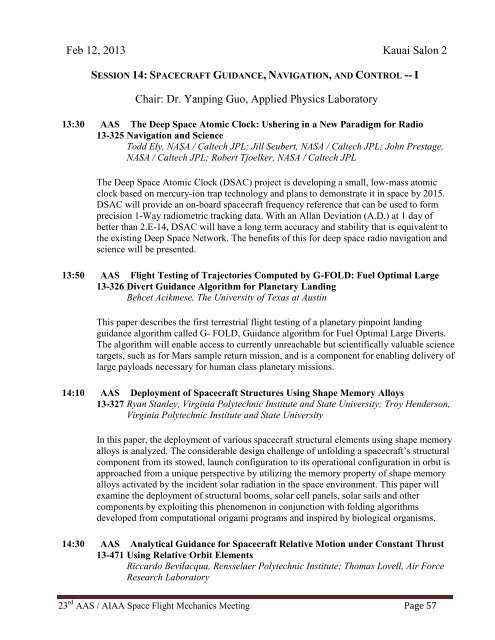meetings - Space Flight Mechanics Committee
meetings - Space Flight Mechanics Committee
meetings - Space Flight Mechanics Committee
Create successful ePaper yourself
Turn your PDF publications into a flip-book with our unique Google optimized e-Paper software.
Feb 12, 2013 Kauai Salon 2<br />
SESSION 14: SPACECRAFT GUIDANCE, NAVIGATION, AND CONTROL -- I<br />
Chair: Dr. Yanping Guo, Applied Physics Laboratory<br />
13:30 AAS The Deep <strong>Space</strong> Atomic Clock: Ushering in a New Paradigm for Radio<br />
13-325 Navigation and Science<br />
Todd Ely, NASA / Caltech JPL; Jill Seubert, NASA / Caltech JPL; John Prestage,<br />
NASA / Caltech JPL; Robert Tjoelker, NASA / Caltech JPL<br />
The Deep <strong>Space</strong> Atomic Clock (DSAC) project is developing a small, low-mass atomic<br />
clock based on mercury-ion trap technology and plans to demonstrate it in space by 2015.<br />
DSAC will provide an on-board spacecraft frequency reference that can be used to form<br />
precision 1-Way radiometric tracking data. With an Allan Deviation (A.D.) at 1 day of<br />
better than 2.E-14, DSAC will have a long term accuracy and stability that is equivalent to<br />
the existing Deep <strong>Space</strong> Network. The benefits of this for deep space radio navigation and<br />
science will be presented.<br />
13:50 AAS <strong>Flight</strong> Testing of Trajectories Computed by G-FOLD: Fuel Optimal Large<br />
13-326 Divert Guidance Algorithm for Planetary Landing<br />
Behcet Acikmese, The University of Texas at Austin<br />
This paper describes the first terrestrial flight testing of a planetary pinpoint landing<br />
guidance algorithm called G- FOLD, Guidance algorithm for Fuel Optimal Large Diverts.<br />
The algorithm will enable access to currently unreachable but scientifically valuable science<br />
targets, such as for Mars sample return mission, and is a component for enabling delivery of<br />
large payloads necessary for human class planetary missions.<br />
14:10 AAS Deployment of <strong>Space</strong>craft Structures Using Shape Memory Alloys<br />
13-327 Ryan Stanley, Virginia Polytechnic Institute and State University; Troy Henderson,<br />
Virginia Polytechnic Institute and State University<br />
In this paper, the deployment of various spacecraft structural elements using shape memory<br />
alloys is analyzed. The considerable design challenge of unfolding a spacecraft’s structural<br />
component from its stowed, launch configuration to its operational configuration in orbit is<br />
approached from a unique perspective by utilizing the memory property of shape memory<br />
alloys activated by the incident solar radiation in the space environment. This paper will<br />
examine the deployment of structural booms, solar cell panels, solar sails and other<br />
components by exploiting this phenomenon in conjunction with folding algorithms<br />
developed from computational origami programs and inspired by biological organisms.<br />
14:30 AAS Analytical Guidance for <strong>Space</strong>craft Relative Motion under Constant Thrust<br />
13-471 Using Relative Orbit Elements<br />
Riccardo Bevilacqua, Rensselaer Polytechnic Institute; Thomas Lovell, Air Force<br />
Research Laboratory<br />
23 rd AAS / AIAA <strong>Space</strong> <strong>Flight</strong> <strong>Mechanics</strong> Meeting Page 57
















